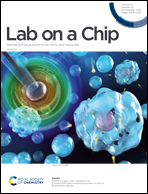Probing mutual interactions between Pseudomonas aeruginosa and Candida albicans in a biofabricated membrane-based microfluidic platform†
Abstract
Microbes are typically found in multi-species (polymicrobial) communities. Cooperative and competitive interactions between species, mediated by diffusible factors and physical contact, leads to highly dynamic communities that undergo changes in composition diversity and size. Infections can be more severe or more difficult to treat when caused by multiple species. Interactions between species can improve the ability of one or more species to tolerate anti-microbial treatments and host defenses. Pseudomonas aeruginosa (Pa), a ubiquitous bacterium, and the opportunistic pathogenic yeast, Candida albicans (Ca), are frequently found together in cystic fibrosis lung infections and wound infections. While significant progress has been made in determining interactions between Pa and Ca, there are still important questions that remain unanswered. Here, we probe the mutual interactions between Pa and Ca in a custom-made microfluidic device using biopolymer chitosan membranes that support cross-species communication. By assembling microbes in physically separated, chemically communicating populations or bringing into direct interactions in a mixed culture, in situ polymicrobial growth and biofilm morphology were qualitatively characterized and quantified. Our work reveals new dynamic details of their mutual interactions including cooperation, competition, invasion, and biofilm formation. The membrane-based microfluidic platform can be further developed to understand the polymicrobial interactions within a controlled interactive microenvironment to improve microbial infection prevention and treatment.



 Please wait while we load your content...
Please wait while we load your content...